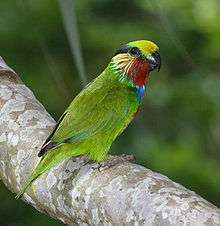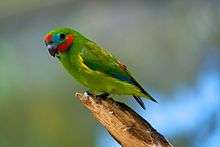Fig parrot
Fig parrots (Cyclopsittini) are a small tribe of Australasian parrots in the family Psittaculidae, made up of five species in two genera (Cyclopsitta and Psittaculirostris). Fig parrots are found on and around the island of New Guinea, within the territories of Indonesia, Papua New Guinea, and tropical Australia.[2]
| Fig parrot | |
|---|---|
 | |
| Edwards's fig parrot | |
| Scientific classification | |
| Kingdom: | Animalia |
| Phylum: | Chordata |
| Class: | Aves |
| Order: | Psittaciformes |
| Family: | Psittaculidae |
| Subfamily: | Loriinae |
| Tribe: | Cyclopsittini |
| Genera | |
| Synonyms[1] | |
| |
Description
Fig parrots are small, stocky, arboreal parrots with short, wedge-shaped tails. They possess proportionately large, broad bills and smooth tongues. Sexual dimorphism is typically pronounced, with the exception of Coxen's fig parrot (Cyclopsitta diopthalma coxeni). Those in the genus Cyclopsitta are generally smaller than those in Psittaculirostris.[2]
Their preferred habitats are the tropical and subtropical rainforests, though they can also be found foraging in the surrounding biomes. They can usually be seen flying swiftly in straight lines, well above the tree canopy.[2]
Their diets consist mainly of fruit, particularly their namesake figs. They may supplement these with a variety of other fruits and berries, along with nectar, pollen, insects, and larvae. Fig parrots appear to be capable of detecting the fig syconia that have been implanted with growing fig wasps, and targeting these for their extra nutritional content. They remember particular fruit trees, and return to them repeatedly over months and years.[2]
Taxonomy
The fig parrot group was first proposed in 1891 at family rank, as Cyclopsittacidae, from the type genus Cyclopsitta.[1] This was later downgraded to tribe status and included into the family Psittaculidae.
Molecular phylogenetic studies support a grouping of fig parrots (Cyclopsittini) with the closely related budgerigars (Melopsittacini) and the lories and lorikeets (Loriini) as the subfamily Loriinae.[3][4] Relationships between the tribes and within the Cyclopsitta and Psittaculirostris remain to be studied in detail.
Tribe Cyclopsittini
| Image | Genus | Living Species |
|---|---|---|
 | Cyclopsitta |
|
 | Psittaculirostris L. Reichenbach, 1850 |
|
See also
References
- Joseph, Leo; Toon, Alicia; Schirtzinger, Erin E.; Wright, Timothy F.; Schodde, Richard (2012-02-24). "A revised nomenclature and classification for family-group taxa of parrots (Psittaciformes)". Zootaxa. 3205 (1): 26–40. doi:10.11646/zootaxa.3205.1.2. ISSN 1175-5334.
- Forshaw, Joseph Michael (2017). Vanished and vanishing parrots : profiling extinct and endangered species. Illustrated by Frank Knight. Collingwood: CSIRO Publishing. pp. 136–140. ISBN 978-0-643-10649-9. OCLC 1007061081.
- Rus, A. Villa; Cigudosa, J.; Juan, J. Carrasco; Gomez, A. Otero; Almeida, T. Acosta; Joshua, S.; Miranda, J. Garcia (2016-09-06). "Chromosomal Evolution in Psittaciformes. Revisited". International Journal of Biology. 8 (4): 34–65. doi:10.5539/ijb.v8n4p34. ISSN 1916-9671.
- Provost, Kaiya L.; Joseph, Leo; Smith, Brian Tilston (2018-01-02). "Resolving a phylogenetic hypothesis for parrots: implications from systematics to conservation". Emu - Austral Ornithology. 118 (1): 7–21. doi:10.1080/01584197.2017.1387030. ISSN 0158-4197.